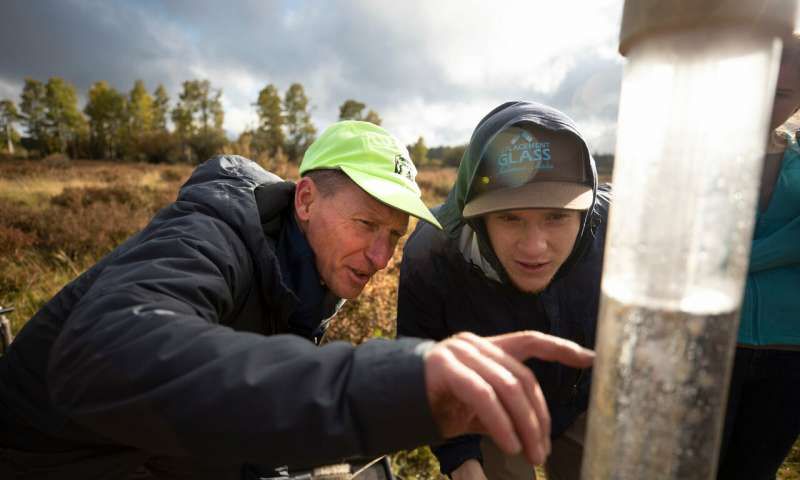Researchers to Find People Willing to Pay to Protect Aquifer Recharge and Water Supply
Published on by Water Network Research, Official research team of The Water Network in Business
Three Northern Arizona University researchers completed the first study ever done that looks at how much people are willing to pay to protect aquifer recharge, as well as the forest ecosystem, culturally significant lands and recreational access as outcomes of forest restoration.

Abe Springer works with a student on his hydrogeology research. Credit: Northern Arizona University
Julie Mueller, an associate professor of economics in the W. A. Franke College of Business, Adrienne Soder, a master’s student in environmental science and policy, and Abe Springer, a professor of hydrogeology and ecohydrology in the School of Earth and Sustainability authored the study, published in Landscape and Urban Planning, which found residents of the Phoenix metropolitan area are willing to pay to protect critical habitats, access to recreation, surface and groundwater and culturally significant areas around the Salt and Verde River watershed, though not to the same degree.
It’s a step toward helping land managers and water providers determine how to move forward in protecting one of the most critical resources in the arid American Southwest.
“Public and community support are very important for achieving successful conservation and restoration,” Soder said. “This study informs watershed managers about public preferences for restoration projects, which holds value separate from the monetary values we estimated.”
This research, which builds on previous work Mueller and Springer have done, asks residents in the Phoenix metro area to compare the outcomes of two hypothetical restoration projects and whether they would pay a predetermined cost to support either project or neither project. They were presented with several of these scenarios. Using an economic model, Mueller estimated residents are willing to pay a one-time fee to support projects that target different environmental factors:
- Protection of critical habitat: $41.92
- Improved surface water quality: $40.19
- One-month forest closure during wildfire season: $25.81
- Preservation of culturally significant areas: $23.33
- Increase in groundwater recharge: $1.30
That means yes, people are willing to pay, but how much and what they’re willing to pay for varies wildly, as do the contributing factors, including depending on how the respondents use the land. People who recreate in the forest are more likely to want to protect it during wildfire season, for example. Overall, this is good news, Soder said. However, although Phoenix water providers already engage in extensive public outreach, some results indicate room for more education on the connection of the forests to the water supply.
“The results show the public cares for the source of their water supply and is actually willing to pay to protect it,” she said. “However, the significantly lower value estimate for groundwater recharge suggests the public is not aware of the connection between groundwater and surface water. Springs provide groundwater to rivers and streams, supporting flow during dry months. Our study reveals this disconnect, highlighting an opportunity for public outreach to bridge this knowledge gap. Public knowledge of where their water comes from may help to secure future water resources, especially as climate change and drought threaten the availability of surface water.”
In addition to the study being the first to consider non-market value for the process of water recharge to aquifers, it also is one of only a few studies to consider cultural values; Soder said this information is a significant contribution to related literature. That is an especially significant question with these lands because the Salt-Verde River watershed has a rich cultural history that includes the cultural use of springs, which are found at the headwater of every perennial stream in the watershed.
The next step in this research for Soder is to expand its use to a broader community. She is working on a method that uses Geographic Information Systems to spatially analyze the results from this experiment, which will make those results more applicable to the decision-making process led by land managers and water providers.
Reference:
Julie M.Mueller, Adrienne B.Soder, Abraham E.Springer, "Valuing attributes of forest restoration in a semi-arid watershed", Landscape and Urban Planning, Volume 184, April 2019, Pages 78-87, DOI: 10.1016/j.landurbplan.2018.12.012
Source: Northern Arizona University
Media
Taxonomy
- Rural Water Supply & Sanitation
- Water Supply
- Aquifer
- Aquifer Recharge
- Water Supply
- Water Supply Commission
- Water Supply & Drainage
- Water Supply Design
- Rural Area Water Supply
- Urban Water Supply
- Spring Water Supply
- Aquifer Recharge
- Aquifer Treatment
- Water Supply Protection